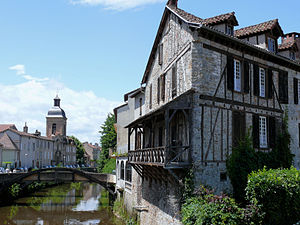Saint-Céré
|
Saint-Céré Sant Seren |
||
|---|---|---|

|
|
|
| region | Occitania | |
| Department | Lot | |
| Arrondissement | Figeac | |
| Canton | Saint-Céré (main town) | |
| Community association | Causses et Vallée de la Dordogne | |
| Coordinates | 44 ° 52 ′ N , 1 ° 54 ′ E | |
| height | 141-523 m | |
| surface | 11.33 km 2 | |
| Residents | 3,462 (January 1, 2017) | |
| Population density | 306 inhabitants / km 2 | |
| Post Code | 46400 | |
| INSEE code | 46251 | |
 Saint-Céré - The Bave River and the Recollect Church |
||
Saint-Céré ( Occitan : Sant Seren ) is a municipality with 3462 inhabitants (as of January 1, 2017) in the Lot department in the French region of Occitania .
location
Saint-Céré is located on the river Bave in the northeast of the Quercy landscape, which is extremely rich in cultural and culinary attractions . The capital of the Quercy, Cahors , is about 80 kilometers (driving distance) in a south-westerly direction, to Gramat it is about 20 kilometers in a south-westerly direction. The idyllic villages Loubressac and Autoire are about 10 and 7 kilometers to the west.
Population development
| year | 1968 | 1975 | 1982 | 1990 | 1999 | 2007 |
| Residents | 3,926 | 4,089 | 4,056 | 3,760 | 3,515 | 3,560 |
history
In Gallo-Roman times there was a fortified hilltop settlement called castrum on one of the hills surrounding the place. The legends about the two local saints Serenus and his daughter Speria, who would rather consecrate her life to God than marry and therefore suffered a martyr's death, date from the 8th century. In the Middle Ages, the place belonged to the property of the Turenne vice-county . During the Hundred Years War (1337-1453) Saint-Céré was occupied by the English for a few years, but major destruction did not take place. During the Huguenot Wars (1562–1598), however, there was some devastation (see also: Saint-Laurent-les-Tours ).
Attractions
- The origins of the Église Sainte-Spérie possibly go back to the 10th century ( crypt ). The single nave nave and the apse are still Romanesque, but were provided with a rib vault or side chapels for stabilization in the 15th century . In the 18th century, today's west tower was placed in front of the entrance portal. In the apse there is an altarpiece with the figures of Saint-Spérie as well as Saint-Pierre and Saint-Paul. The stained glass windows from the 19th century show the martyrdom of the saints ( choir ) and the twelve apostles (nave).
- The church of the Franciscan Recollects ( Église des Récollets ) on the banks of the Bave, also single-aisled with a wooden ceiling and a straight choir closure, dates from the 17th century . Its demolition during the French Revolution was prevented and from 1806 it was used again for cult purposes. The tower was added to the structure in 1859. The altarpiece also comes from the 17th century.
- In the alleys and streets of the old town of Saint-Céré - around the Place du Mercadial - some half-timbered houses ( maisons à colombages ) have survived .
- The multi-towered castle Château de Saint-Laurent Les Tours , located on a hilltop, towers over the town. During the German occupation of northern France in World War II, it was the artist Jean Lurçat's second home for years .
- The Château de Montal , about two kilometers outside, is a two-wing renaissance castle from the first half of the 16th century with mighty round towers on the sides that are reminiscent of the Middle Ages. It has been converted into a hotel restaurant, but can also be visited.
Personalities
- Jean de la Barrière (1544–1600), founder of the Feuillanten
- Jean-Jacques Ambert (1765-1851), General
- Charles Bourseul (1829–1912), pioneer of electromagnetic voice transmission
- François Certain de Canrobert (1809–1895), Marshal of France
- Pierre Poujade (1920–2003), businessman and right-wing populist politician
Community partnerships
- Allersberg , Germany
